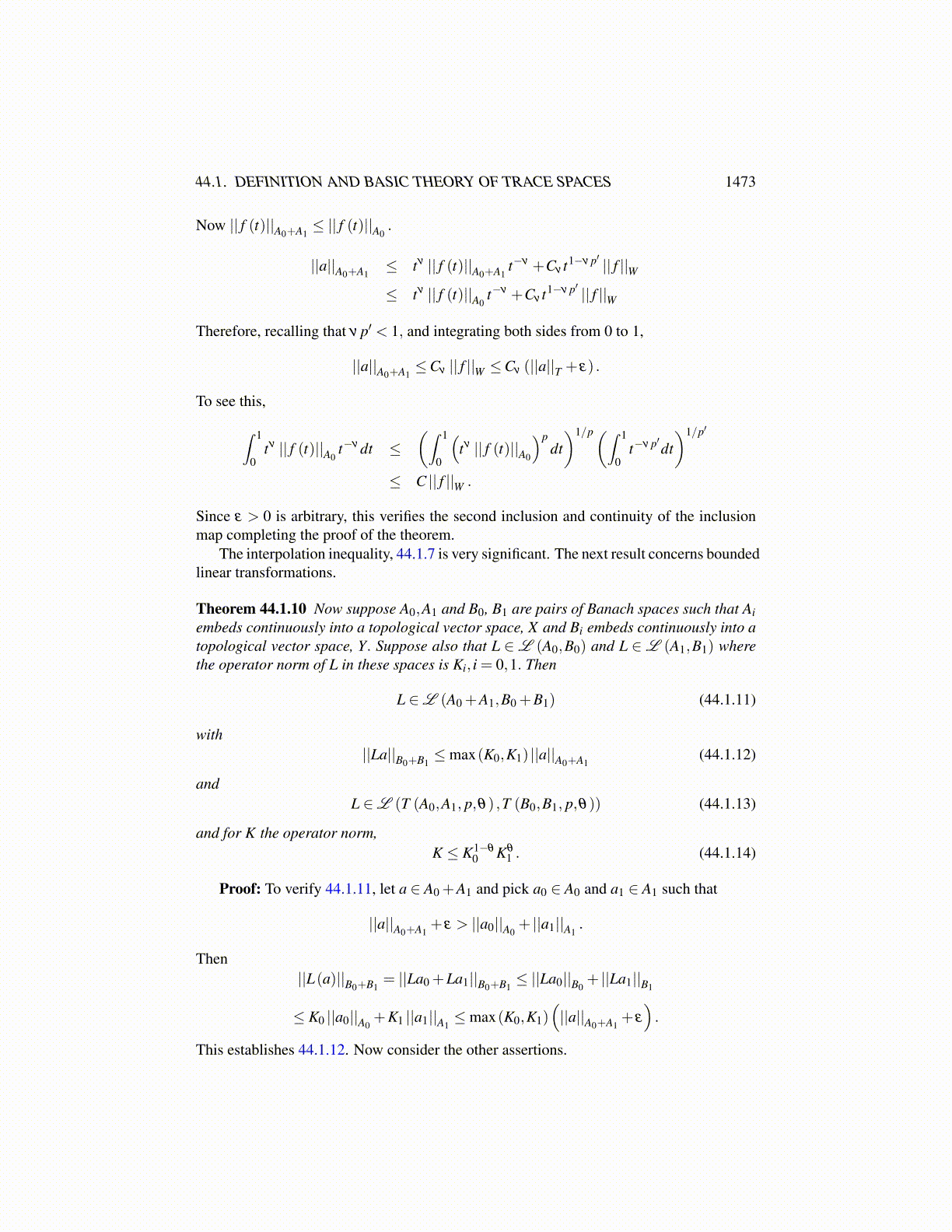
44.1. DEFINITION AND BASIC THEORY OF TRACE SPACES 1473
Proof: Define a mapping, ψ : W/Z→ T by
ψ ([ f ])≡ γ f .
Then ψ is one to one and onto. Also
||[ f ]|| ≡ inf{|| f +g|| : g ∈ Z}= inf{||h||W : γh = γ f}= ||γ ( f )||T .
Therefore, the Banach space, W/Z and T are isometric and so T must be a Banach spacesince W/Z is.
The following is an important interpolation inequality.
Theorem 44.1.9 If a ∈ T, then
||a||T = inf{∣∣∣∣∣∣tθ f
∣∣∣∣∣∣1−θ
Lp(0,∞, dtt ;A0)
∣∣∣∣∣∣tθ f ′∣∣∣∣∣∣θ
Lp(0,∞, dtt ;A1)
}(44.1.6)
where the infimum is taken over all f ∈W such that a = f (0) . Also, if a ∈ A0 ∩A1, thena ∈ T and
||a||T ≤ K ||a||1−θ
A1||a||θA0
(44.1.7)
for some constant K. Also
A0∩A1 ⊆ T (A0,A1, p,θ)⊆ A0 +A1 (44.1.8)
and the inclusion maps are continuous.
Proof: First suppose f (0) = a where f ∈W . Then letting fλ (t) ≡ f (λ t) , it followsthat fλ (0) = a also and so
||a||T ≤ max(∣∣∣∣∣∣tθ fλ
∣∣∣∣∣∣Lp(0,∞, dt
t ;A0),∣∣∣∣∣∣tθ ( fλ )
′∣∣∣∣∣∣
Lp(0,∞, dtt ;A1)
)= max
(λ−θ
∣∣∣∣∣∣tθ f∣∣∣∣∣∣
Lp(0,∞, dtt ;A0)
,λ 1−θ
∣∣∣∣∣∣tθ f ′∣∣∣∣∣∣
Lp(0,∞, dtt ;A1)
)≡ max
(λ−θ R,λ 1−θ S
).
Now choose λ = R/S to obtain
||a||T ≤ R1−θ Sθ =∣∣∣∣∣∣tθ f
∣∣∣∣∣∣1−θ
Lp(0,∞, dtt ;A0)
∣∣∣∣∣∣tθ f ′∣∣∣∣∣∣θ
Lp(0,∞, dtt ;A1)
.
Thus
||a||T ≤ inf{∣∣∣∣∣∣tθ f
∣∣∣∣∣∣1−θ
Lp(0,∞, dtt ;A0)
∣∣∣∣∣∣tθ f ′∣∣∣∣∣∣θ
Lp(0,∞, dtt ;A1)
}.
Next choose f ∈W such that f (0) = a and || f ||W ≈ ||a||T . More precisely, pick f ∈Wsuch that f (0) = a and ||a||T >−ε + || f ||W . Also let
R≡∣∣∣∣∣∣tθ f
∣∣∣∣∣∣Lp(0,∞, dt
t ;A0),S≡
∣∣∣∣∣∣tθ f ′∣∣∣∣∣∣
Lp(0,∞, dtt ;A1)
.